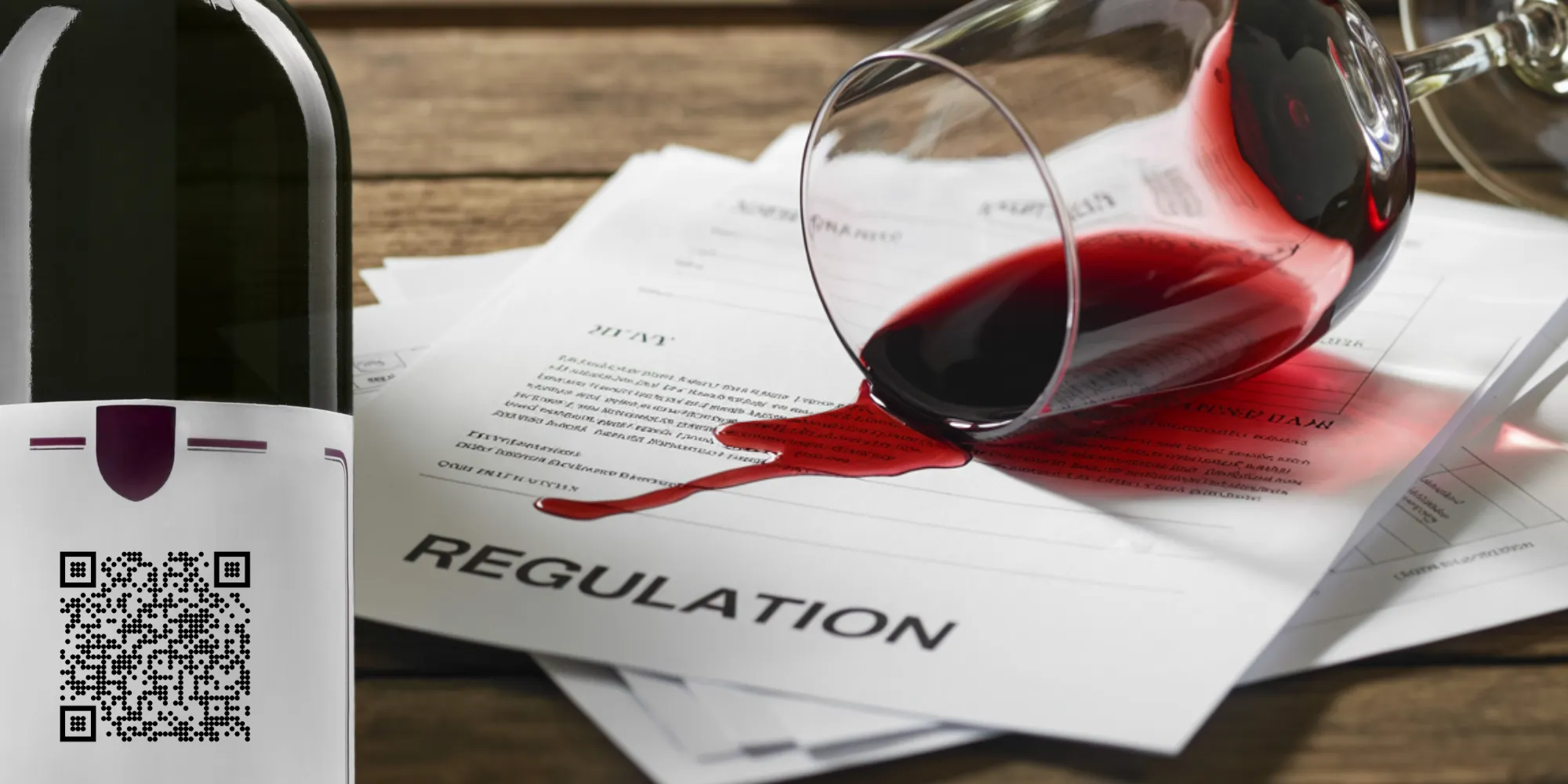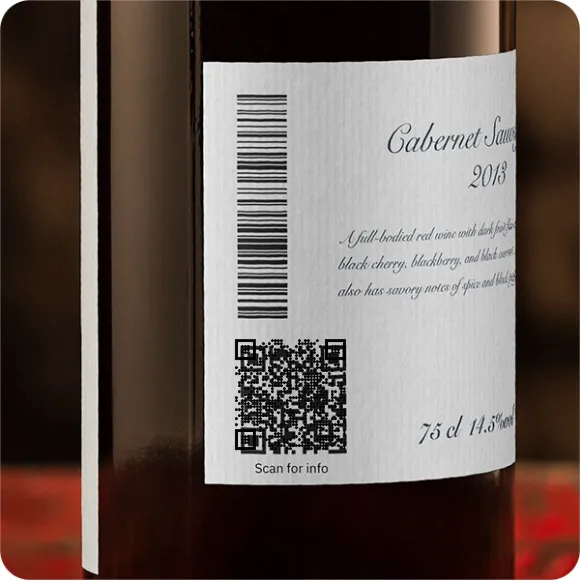The Ultimate Guide to EU Wine Labeling Compliance

Too Long; Don't Want to Read? We get it - compliance research can be overwhelming. If you'd rather skip the deep dive and get straight to a solution that works, contact us today. We'll handle your complete EU wine labeling compliance in hours, not weeks, so you can focus on making great wine instead of navigating regulations.
The European Union's wine labeling revolution isn't just about compliance - it's about fundamentally reshaping how wineries connect with consumers, protect their brands, and manage their supply chains. While many producers view the December 8, 2023 deadline as a regulatory headache, forward-thinking wineries are discovering that the right approach to compliance creates lasting competitive advantages that extend far beyond meeting legal requirements.
Why This Matters More Than You Think
The Bottom Line: EU Regulation 2021/2117 requires all wine sold in Europe to display comprehensive ingredient, nutritional, energy, and allergen information. But this regulation represents something much bigger - an opportunity to build direct consumer relationships, protect brand integrity, and create supply chain transparency that modern consumers increasingly demand.
Key Compliance Dates:
- December 8, 2023: All wine produced after this date must be compliant
- Pre-December 2023 wine: Exempt until stocks are exhausted
- Non-compliance consequences: Market removal and administrative penalties
The Smart Solution: Digital labeling through QR codes and connected packaging transforms regulatory compliance into a strategic business asset.
Chapter 1: Understanding the Regulatory Landscape
What Changed and Why It Matters
The EU's wine labeling overhaul represents the most significant regulatory change in the wine industry in decades. Regulation (EU) 2021/2117 requires ingredient, nutrition, energy, and allergen information along with wines sold in the EU starting December 8, 2023, but subsequent clarifications and amendments have created a complex compliance framework that many wineries still struggle to understand.
Core Requirements for Physical Labels:
- Energy content (displayed with "E" symbol per 100ml)
- Allergen and intolerance information
- Alcohol strength by volume
- Provenance indication
- Producer/bottler identification
- Importer details (for imported wines)
- Sugar content (sparkling wines)
- Minimum durability date (de-alcoholized wines under 10% ABV)
- Lot identification
- Net quantity

Digital Label Requirements (QR Code/URL):
- Complete ingredient list (descending order by weight)
- Comprehensive nutritional information
- Detailed allergen declarations
- Energy calculations using approved methods
The Hidden Complexity: What Most Guides Don't Tell You
Beyond the basic requirements lies a labyrinth of nuanced regulations that can trap unprepared wineries:
Additive Flexibility Rules: For additives that vary from bottle to bottle, the new regulation requires that the ingredient list include an exhaustive list of additives that could potentially be used in the winemaking process. This means your digital labels must account for production variability while maintaining accuracy.
Multi-Vintage Challenges: Champagne houses and producers blending different vintages face unique compliance hurdles. Draft regulations suggest exhaustive ingredient lists that cover all possible components across vintages.
Language Requirements: Each EU member state can specify required languages for digital labels. Most global brands are preparing translations in all 24 EU languages to ensure comprehensive market access.
The "Field of Vision" Concept: Critical information must be visible without rotating the bottle, though substances causing allergies or intolerances, importer indication, lot number, and minimum durability date can be listed outside the field of vision.
Chapter 2: The Strategic Approach to Compliance
Beyond Checkbox Compliance: Building Competitive Advantage
Smart wineries aren't just meeting regulatory requirements - they're transforming compliance into a comprehensive business strategy that addresses multiple challenges simultaneously.
The Connected Packaging Revolution
While traditional compliance approaches focus on meeting minimum legal requirements, connected packaging solutions create a comprehensive platform for:
Brand Protection: Every QR code becomes a unique digital fingerprint that can detect counterfeiting and gray market diversion. When the same code appears in multiple geographic locations simultaneously, it triggers automatic fraud alerts.
Supply Chain Intelligence: Real-time scanning data provides unprecedented visibility into product movement, enabling optimized logistics, precise inventory management, and rapid response to distribution issues.
Consumer Engagement: The same QR code serving compliance information can provide localized content, authentication verification, and brand storytelling- creating direct consumer relationships previously impossible through traditional distribution channels.
Regulatory Future-Proofing: As additional regulations emerge across global markets, existing QR code infrastructure can be updated to accommodate new requirements without reprinting labels or redesigning packaging.
The Four-Phase Implementation Strategy
Phase 1: Information Architecture
Create a comprehensive database structure that captures all required information while building flexibility for future needs:
Product Specifications:
- Wine variety and vintage details
- Alcohol by volume percentage
- Sugar content measurements
- Net quantity specifications
- Geographic origin documentation
- Producer and bottler identification
Ingredient Management:
- Primary ingredients in weight-descending order
- Additive categories with "and/or" flexibility
- Processing aid documentation
- Acidity regulator specifications
- Stabilizing agent alternatives
Nutritional Data:
- Energy calculations using EU-approved methods
- Macronutrient breakdowns (carbohydrates, sugars, fat, saturates, protein, salt)
- Serving size variations (100ml mandatory, plus regional preferences)
Allergen Documentation:
- Comprehensive allergen screening
- Intolerance trigger identification
- Cross-contamination risk assessment
Phase 2: Technology Integration
Deploy a scalable digital platform that handles current requirements while providing expansion capability:
Core Platform Requirements:
- Dynamic QR code generation with unique serialization
- Multi-language translation management
- Bulk data import/export capabilities
- API integration for existing systems
- Real-time content management
- Geographic content targeting
- Analytics and scanning intelligence
Quality Assurance Systems:
- Automated compliance checking
- Translation accuracy verification
- Link functionality testing
- Mobile compatibility validation
- Accessibility standards compliance
Phase 3: Design and Production
Integrate compliance elements into packaging design while maintaining brand integrity:
QR Code Optimization:
- Minimum 13mm x 13mm sizing for reliable scanning
- High contrast design (black on white recommended)
- Adequate quiet zone spacing (minimum 1.5mm for 10mm codes)
- 300+ DPI resolution for print quality
- Strategic placement for easy consumer access
Label Design Integration:
- Compliance information hierarchy
- Call-to-action clarity ("Scan for ingredients" or similar)
- Brand consistency maintenance
- Multi-market optimization
- Physical space allocation for required text elements
Phase 4: Deployment and Monitoring (Ongoing)
Launch compliance system with comprehensive monitoring and optimization:
Performance Tracking:
- Scan rate analysis by region and product
- Consumer engagement metrics
- Compliance accuracy monitoring
- Supply chain visibility reports
- Brand protection incident detection
Continuous Improvement:
- Regular content updates based on production changes
- Translation refinements
- User experience optimization
- Regulatory update integration
- Market expansion preparation
Chapter 3: Technical Deep Dive - Getting It Right
Energy Calculation Methods: Precision Matters
EU regulations specify two acceptable methods for calculating energy content:
Method 1: Formula-Based Calculation Using conversion factors based on alcohol content, residual sugars, and organic acids. This method provides consistent results but requires precise measurement of component levels.
Method 2: Laboratory Analysis Direct measurement of energy content through laboratory testing. While more expensive, this method provides the highest accuracy for complex products.
Pro Tip: Leading platforms provide automated calculators that handle both methods, reducing calculation errors and ensuring consistency across product lines.
Ingredient Listing Complexity
The regulation's flexibility around additive listing creates both opportunities and potential compliance traps:
Standard Ingredients: Must be listed in strict descending order by weight as present in the final product.
Variable Additives: For acidity regulators and stabilizing agents, up to three alternatives can be listed using "contains... and/or" language, provided at least one is present in the final product.
Packaging Gases: Can be omitted from ingredient lists if using approved statements like "Bottled in a protective atmosphere" or "Bottling may happen in a protective atmosphere."
Translation Management at Scale
Managing accurate translations across 24 EU languages requires systematic approaches:
Technical Terminology: Wine-specific terms, additive names, and regulatory language must be precisely translated to maintain compliance accuracy.
Cultural Localization: While maintaining technical accuracy, content should be culturally appropriate for each market.
Update Propagation: Changes to base content must be systematically propagated across all language versions.
Quality Assurance: Native speaker review and regulatory compliance checking for each language version.
Chapter 4: Advanced Applications - Maximizing Your Investment
Geographic Intelligence and Market Protection
Connected packaging enables sophisticated geographic targeting that protects brand positioning across different markets:
Geo-Fencing: Products intended for specific markets can trigger alerts if scanned in unexpected locations, identifying potential gray market diversion.
Market-Specific Content: The same QR code can deliver different content based on scanning location- EU compliance information in Europe, marketing content in other markets.
Distribution Intelligence: Real-time scanning data reveals actual product movement patterns, enabling optimization of distribution strategies.
Supply Chain Transparency
Modern consumers increasingly demand supply chain transparency. Connected packaging provides:
Batch-Level Tracking: Link specific bottles to production batches, enabling precise quality control and targeted recalls if necessary.
Provenance Verification: Detailed origin information builds consumer confidence and supports premium positioning.
Sustainability Metrics: Share environmental impact data, organic certifications, and sustainable farming practices.
Consumer Engagement Beyond Compliance
Transform mandatory QR codes into engagement platforms:
Educational Content: Wine tasting notes, food pairing suggestions, and production stories.
Authentication Services: Allow consumers to verify product authenticity, building trust and protecting against counterfeiting.
Direct Relationships: Capture consumer contact information (with permission) for direct marketing and loyalty programs.
Feedback Collection: Gather consumer preferences and satisfaction data directly from product interaction.
Chapter 5: Rapid Implementation - Getting Compliant Fast
The Proqure Fast-Track Advantage
While traditional compliance approaches can take weeks or months, modern platforms like Proqure enable complete implementation in hours. Here's what the streamlined process looks like:
Immediate Setup (Same Day):
- Product catalog upload via spreadsheet or API integration
- Automated QR code generation for your entire product line
- Multi-language digital labels created instantly
- Compliance verification across all regulatory requirements
Quality Assurance (Within 24 Hours):
- Automated compliance checking against current EU regulations
- QR code functionality testing across all devices
- Translation accuracy verification by native speakers
- Brand consistency review and optimization
Production Ready (24-48 Hours):
- Print-ready QR codes delivered in multiple formats
- Integration with existing label designs
- Staff training materials and documentation
- Ongoing content management system setup
Why Speed Matters in Wine Compliance
Market Window Protection: Every day of non-compliance risks product removal from lucrative EU markets during peak selling seasons.
Competitive Advantage: Early adopters gain consumer trust and market positioning while competitors struggle with complex implementation.
Cost Management: Rapid deployment minimizes disruption to existing production schedules and inventory management.
Risk Mitigation: Quick compliance reduces exposure to regulatory penalties and supply chain disruptions.

Chapter 6: Measuring Success - KPIs That Matter
Compliance Metrics
Primary Compliance Indicators:
- Percentage of product portfolio in compliance
- Accuracy rate of digital label information
- Translation quality scores across all languages
- Regulatory update response time
Secondary Compliance Indicators:
- QR code print quality consistency
- Link functionality uptime
- Mobile compatibility across devices
- Content loading speed performance
Business Impact Metrics
Brand Protection:
- Counterfeit detection incidents
- Gray market diversion alerts
- Brand authentication requests
- Consumer fraud reports
Supply Chain Intelligence:
- Real-time inventory visibility improvement
- Logistics optimization savings
- Recall precision improvements
- Distribution partner compliance rates
Consumer Engagement:
- QR code scan rates by product and region
- Consumer information consumption patterns
- Direct relationship building metrics
- Feedback and rating collection volumes
Return on Investment Calculation
Direct Compliance Costs:
- Platform subscription fees
- Implementation and setup costs
- Translation and content management
- Label reprinting expenses
Quantifiable Benefits:
- Counterfeit protection value
- Gray market loss prevention
- Supply chain efficiency gains
- Premium positioning support
- Direct consumer relationship value
Long-Term Strategic Value:
- Regulatory future-proofing
- Market expansion enablement
- Brand protection insurance
- Consumer trust building
Chapter 7: Future-Proofing Your Compliance Strategy
Emerging Regulatory Trends
Global Expansion of Similar Requirements:
- US TTB evaluating similar labeling requirements
- Asian markets considering transparency regulations
- Sustainability reporting becoming mandatory
- Traceability requirements expanding
Technology Integration Requirements:
- GS1 Digital Link compatibility becoming standard
- Blockchain integration for authenticity verification
- IoT sensors for supply chain monitoring
- AI-powered content personalization
Building Scalable Systems
Platform Architecture Considerations:
- API-first design for system integration
- Microservices architecture for component flexibility
- Cloud-native deployment for global scalability
- Open standards compliance for interoperability
Organizational Readiness:
- Cross-functional team establishment
- Process documentation and standardization
- Staff training and capability building
- Vendor relationship management
Conclusion: Transform Compliance into Competitive Advantage in Hours, Not Months
The EU wine labeling regulations represent far more than a compliance obligation- they're a catalyst for digital transformation that creates lasting competitive advantages. While competitors struggle with complex implementation timelines, smart wineries are achieving complete compliance and building comprehensive business capabilities in days.
The key is choosing a platform that handles complexity behind the scenes while delivering immediate results. By investing in connected packaging solutions that address regulatory requirements while building broader business capabilities, wineries transform a compliance cost into a revenue-generating asset.
The Proqure Speed Advantage: Complete EU wine labeling compliance doesn't require weeks of development, complex technical integration, or extensive staff training. Proqure's platform enables full implementation in hours with built-in scalability for global expansion and automatic updates for future regulatory requirements.
Ready to get compliant fast and transform regulatory requirements into competitive advantage? Proqure provides same-day wine compliance solutions that protect your brand, optimize your supply chain, and build direct consumer relationships- all while ensuring complete regulatory compliance across all EU markets.
Get compliant today: Contact us directly to get your entire product line compliant within 24 hours.
Additional Resources
Regulatory References:
Implementation Support:
- Proqure Platform Demo
- Compliance Checklist Download
- ROI Calculator Tool
- Technical Integration Guide
Disclaimer: This guide provides educational information about EU wine labeling regulations. Always consult current official EU regulations and legal counsel for definitive compliance guidance.



